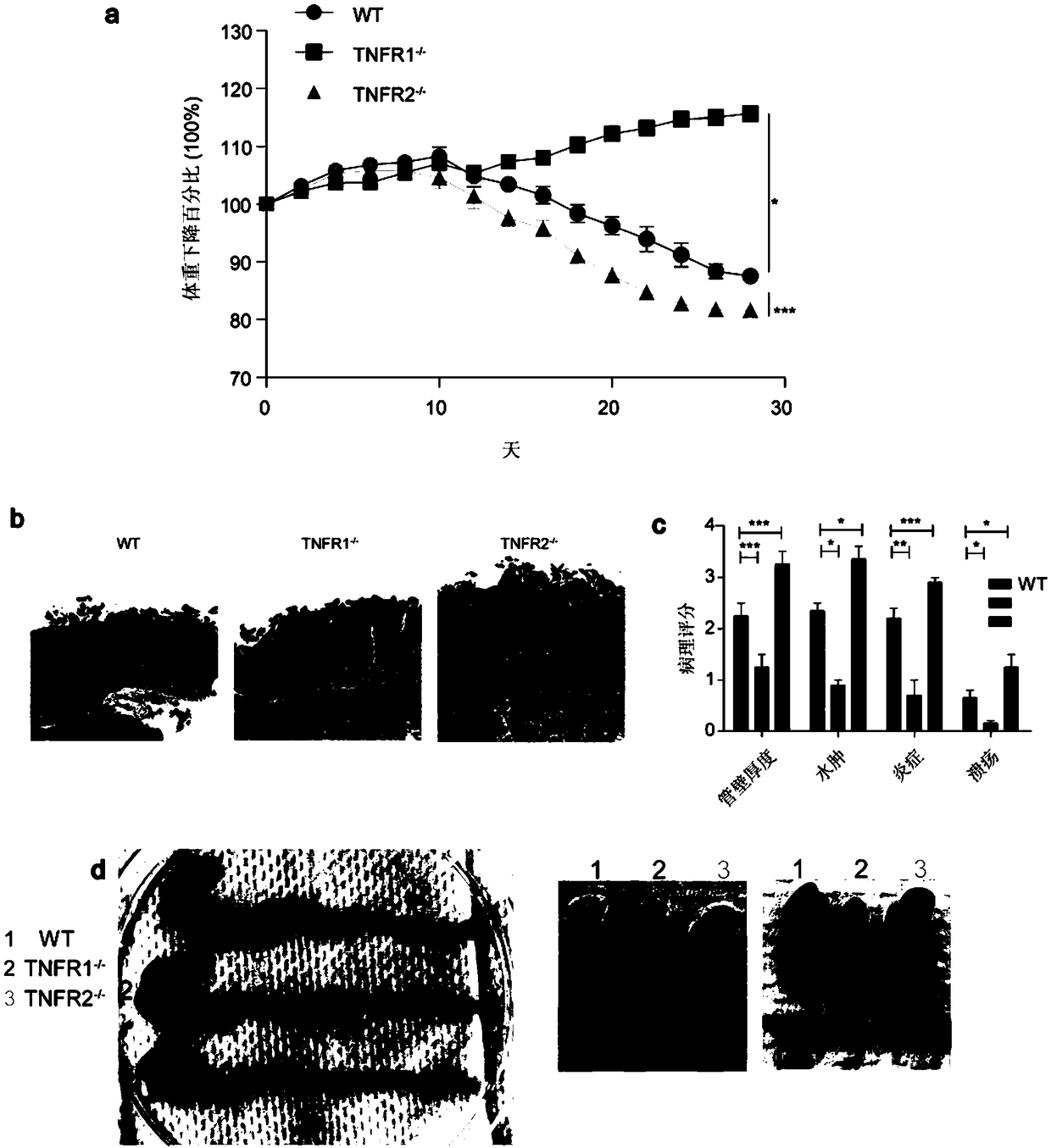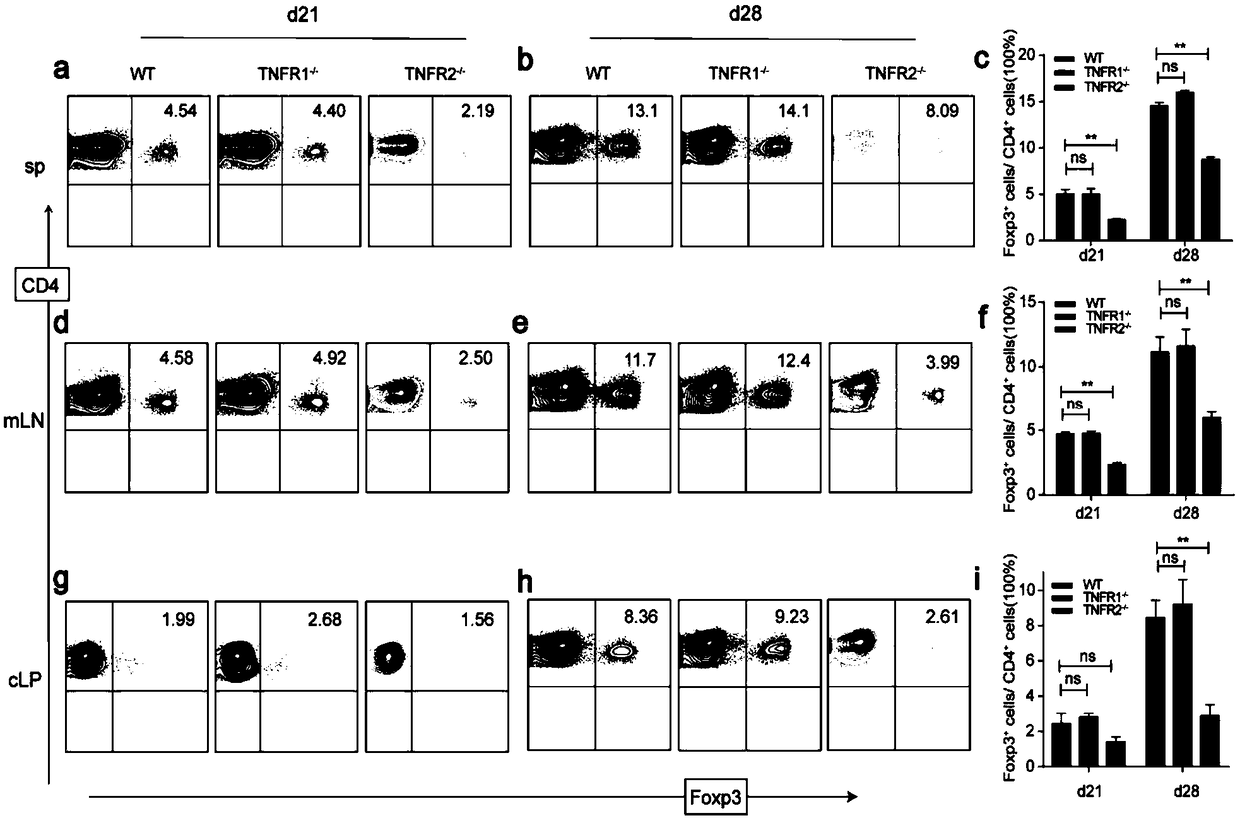TNFR2 gene and application of encoded protein thereof
A gene and encoding technology, applied in the fields of TNFR2 gene and its encoded protein, molecular markers, TNFR2 agonists, and biomarkers, can solve problems such as unclear role of regulatory T cells, so as to avoid serious side effects and reduce drug use effect of dosage
- Summary
- Abstract
- Description
- Claims
- Application Information
AI Technical Summary
Problems solved by technology
Method used
Image
Examples
Embodiment 1
[0078] Example 1 Naive CD4 + Induction of T cells into iTregs in vitro
[0079] The inventor used autoMACS instrument magnetic bead sorting method to extract naive CD4 + T cells. First enrich the spleen cells of the mouse with nylon hair column for T cell enrichment, then add biotin mouse anti-CD8 antibody 6ul, biotin mouse anti-B220 antibody 8ul, biotin mouse anti-CD11b antibody 1.5ul, biotin mouse Anti-CD11c antibody 1.5ul, biotin mouse anti-CD49b 1ul, mix well, and incubate at 4°C for 20 minutes. Then add anti-biotin beads 8ul, mix well, and incubate at 4 degrees for 15 minutes. The autoMACS instrument performs the first step of negative selection to remove non-CD4 + cell. Add mouse CD62L-beads8ul and incubate at 4 degrees for 15 minutes. The autoMACS instrument performs the second step of positive selection. The positive selection tube is naive CD4 + T cells. Detection of naive CD4 by flow cytometry + T cell purity (>90%).
[0080] Next, the inventors extract...
Embodiment 2
[0083] Embodiment 2 naive CD4 + T cells induce Rag1 - / - Mice as a model of colitis
[0084] Select healthy Rag1 of the same age - / - Mice were randomly divided into 3 groups. Extraction of WT, TNFR1 - / - or TNFR2 - / - mouse naive CD4 + T cells, adjust the cell concentration to 3 million / ml, intraperitoneally inject Rag1 - / - For mice, 0.6million (200ul) per mouse. The body weight of each mouse was recorded daily. At the third and fourth weeks after cell injection, the mice were sacrificed, and the 1 mm colon of each mouse was fixed in 10% buffered formalin, embedded in paraffin, blocked, sectioned, and stained with H&E. Monocytes from spleen, mLNs and cLP were collected from recipient mice, counted and fluorescently stained. Foxp3 determined by flow cytometry + , IL-17A + or IFNγ + CD4 + proportion of T cells. The inventors found that TNFR1 - / - The body weight of recipient mice in the group can rise slowly, the pathological manifestation of colitis is the lightes...
Embodiment 3
[0085] Embodiment 3 uses WT, TNFR1 - / - and TNFR2 - / - Mice as subjects to induce EAE model
[0086] Select healthy female WT and TNFR1 at the same age of 8 weeks - / - and TNFR2 - / - Mice were used as test subjects. For each mouse, add 1.2 mg of inactivated Mycobacterium tuberculosis dry powder to 150ul of incomplete Freund's adjuvant to make 150ul of complete Freund's adjuvant containing tuberculin 8mg / ml, mix it with MOG (2mg / ml ) 150ul emulsified in the three-way tube. The pertussis toxin was diluted to 1.25ug / ml with serum-free sterile PBS.
[0087] Subcutaneous injection was performed at three sites on the back of the mouse, each site was 100ul, and PTX was injected intraperitoneally at 200ul (250ng / mouse). On the second day, each mouse was intraperitoneally injected with 250 ng of pertussis toxin. On the seventh day, repeat the operation on the first day, subcutaneously inject 300ug MOG, and intraperitoneally inject 250ng PTX. On the ninth day, repeat the operation o...
PUM
 Login to View More
Login to View More Abstract
Description
Claims
Application Information
 Login to View More
Login to View More - R&D
- Intellectual Property
- Life Sciences
- Materials
- Tech Scout
- Unparalleled Data Quality
- Higher Quality Content
- 60% Fewer Hallucinations
Browse by: Latest US Patents, China's latest patents, Technical Efficacy Thesaurus, Application Domain, Technology Topic, Popular Technical Reports.
© 2025 PatSnap. All rights reserved.Legal|Privacy policy|Modern Slavery Act Transparency Statement|Sitemap|About US| Contact US: help@patsnap.com



